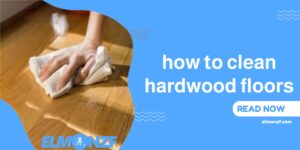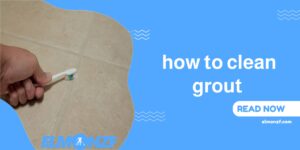how to clean hardwood floors ? Hardwood floors add a touch of elegance and warmth to any home. To maintain their beauty and longevity, regular cleaning is essential. But with so many cleaning methods and products available, it can be overwhelming to know where to start. In this comprehensive guide, we will walk you through the step-by-step process of how to clean hardwood floors effectively, while keeping their natural shine intact. Whether you’re a first-time hardwood floor owner or looking for expert tips, you’ve come to the right place.
Understanding the Importance of Proper Hardwood Floor Cleaning
Cleaning hardwood floors not only enhances their appearance but also ensures their longevity. Over time, dust, dirt, and debris can accumulate on the surface, causing scratches and dullness. Regular cleaning not only removes these particles but also prevents the build-up of harmful substances that can damage the wood. By following the right cleaning techniques, you can keep your hardwood floors looking pristine for years to come.
Essential Tools and Supplies for Cleaning Hardwood Floors
how to clean hardwood floors ? To achieve optimal results when cleaning hardwood floors, it’s crucial to have the right tools and supplies at your disposal. Here are some essentials you’ll need:
- Soft-bristle broom or dust mop: This will help remove loose dirt and debris without scratching the floor.
- Microfiber mop or mop with a soft, non-abrasive head: Ideal for mopping and removing stubborn stains.
- pH-neutral hardwood floor cleaner: Look for a cleaner specifically formulated for hardwood floors to avoid any potential damage.
- Bucket: For mixing the cleaning solution and water.
- White vinegar: An excellent natural alternative for gentle cleaning and stain removal.
- Distilled water: Recommended to prevent mineral deposits on the floor.
- Soft, lint-free cloths or microfiber pads: Use for drying the floor and applying cleaning solutions.
how to clean hardwood floors
Sweeping is a vital step in the cleaning process, as it removes loose dirt, dust, and debris that can scratch the hardwood floor’s surface. Here’s how to sweep hardwood floors effectively:
- Start by removing any obstacles from the floor, such as furniture or rugs, to ensure unrestricted access.
- Use a soft-bristle broom or a dust mop to gently sweep the entire area. Begin at one corner of the room and work your way toward the exit.
- Pay extra attention to high-traffic areas and areas prone to accumulating dirt and debris, such as entryways and hallways.
- For hard-to-reach corners and edges, use a smaller brush or a soft-bristle broom with angled bristles.
- Once you’ve finished sweeping, gather the collected dirt and debris with a dustpan, disposing of it in a waste bin.
The Art of Mopping Hardwood Floors: Dos and Don’ts
Mopping is an essential part of hardwood floor cleaning, but it must be done correctly to avoid causing damage. Follow these dos and don’ts for a successful mopping session:
Dos:
- Do use a microfiber mop or a mop with a soft, non-abrasive head.
- Do mix a mild, pH-neutral hardwood floor cleaner with water according to the manufacturer’s instructions.
- Do dampen the mop, ensuring it’s not soaking wet.
- Do mop in the direction of the wood grain to prevent streaks.
- Do change the mop water as it becomes dirty to avoid spreading dirt around.
Don’ts:
- Don’t use excessive water or soak the mop head, as this can seep into the wood and cause damage.
- Don’t use harsh chemicals, bleach, or ammonia-based cleaners, as they can strip the floor’s finish.
- Don’t leave any standing water on the floor after mopping, as it can warp or stain the wood.
Natural and Homemade Solutions for Deep Cleaning Hardwood Floors
how to clean hardwood floors ? If you prefer natural and homemade solutions for cleaning your hardwood floors, there are several options you can try. Here are a few effective recipes using common household ingredients:
- Vinegar and Water Solution:
- Mix equal parts white vinegar and distilled water in a spray bottle.
- Lightly mist the solution onto the floor, focusing on small sections at a time.
- Wipe the floor with a microfiber mop or a damp cloth, following the wood grain.
- Repeat as needed until the entire floor is clean.
- Lemon Juice and Olive Oil Solution:
- Combine half a cup of lemon juice with one cup of olive oil.
- Apply a small amount of the mixture to a soft cloth or mop head.
- Gently rub the solution onto the floor, working in small sections.
- Buff the floor with a clean cloth to remove any excess oil.
- Tea Solution:
- Steep three black tea bags in boiling water.
- Allow the tea to cool to room temperature.
- Dip a mop or cloth into the tea, wringing out any excess liquid.
- Clean the floor as usual, following the wood grain.
more: how to clean humidifier

Protecting Hardwood Floors from Scratches and Damage
Preventing scratches and damage is as important as cleaning hardwood floors. Here are some tips to protect your floors:
- Use rugs and doormats: Place rugs or mats at entryways and high-traffic areas to trap dirt and prevent it from being tracked onto the floor. Make sure the rugs have a non-slip backing to avoid slips and falls.
- Apply felt pads: Attach felt pads to the bottom of furniture legs to prevent them from scratching the floor when moved or dragged.
- Trim pet nails: Keep your pets’ nails trimmed to minimize the risk of scratches.
- Lift heavy objects: When moving heavy furniture or appliances, avoid dragging them across the floor. Instead, use furniture sliders or enlist the help of others to lift and carry them.
- Avoid high heels and spiked shoes: Discourage wearing high heels or shoes with spikes on hardwood floors, as they can cause deep scratches.
more: how to clean air fryer
Common Mistakes to Avoid When Cleaning Hardwood Floors
While cleaning hardwood floors, it’s crucial to steer clear of certain common mistakes that can lead to damage. Here are a few mistakes to avoid:
- Using excessive water: Overly wet mopping can seep into the wood, causing it to swell, warp, or become discolored. Always wring out the mop thoroughly to avoid saturating the floor.
- Skipping regular sweeping: Neglecting regular sweeping allows dirt and debris to accumulate, increasing the chances of scratches and damage during cleaning.
- Using abrasive tools: Avoid using rough scrub brushes, steel wool, or abrasive cleaners, as they can scratch the floor’s surface and remove the protective finish.
- Neglecting to dry the floor: Leaving the floor wet after mopping can result in water spots, warping, or staining. Ensure the floor is completely dry before walking on it or replacing furniture.
- Using the wrong cleaning products: Harsh chemicals, bleach, ammonia, or oil-based cleaners can damage the finish and strip away the natural shine of hardwood floors. Stick to pH-neutral cleaners specifically designed for hardwood floors.
more: how to clean a tv screen
In conclusion, knowing how to clean hardwood floors properly is essential for maintaining their beauty and longevity. By following the steps and tips outlined in this guide, you can keep your hardwood floors looking pristine and enjoy their natural shine for years to come. Remember to use the right tools, choose the appropriate cleaning solutions, and avoid common mistakes that can damage your floors. With regular care and attention, your hardwood floors will continue to be a stunning centerpiece in your home.
FAQs About how to clean hardwood floors
Can I Use Vinegar to Clean Hardwood Floors?
Yes, you can use a vinegar and water solution to clean hardwood floors effectively. Mix equal parts white vinegar and distilled water in a spray bottle, and lightly mist the solution onto the floor. Remember to wipe the floor with a microfiber mop or a damp cloth, following the wood grain.
How Often Should I Clean My Hardwood Floors?
The frequency of cleaning your hardwood floors depends on several factors, including foot traffic and the presence of pets or young children. As a general rule, it’s recommended to sweep or dust mop daily or every other day to prevent the accumulation of dirt and debris. A deeper clean with a mop can be done weekly or as needed.
Is It Safe to Use Steam Mops on Hardwood Floors?
Using steam mops on hardwood floors can be risky. The excessive heat and moisture from steam can penetrate the wood and cause damage, such as warping or buckling. It’s best to avoid using steam mops and opt for safer cleaning methods like the ones mentioned in this guide.
What Are Some Tips for Removing Tough Stains from Hardwood Floors?
To remove tough stains from hardwood floors, you can try the following tips:
- For water or pet urine stains: Blot the stain immediately with a soft cloth or paper towel. If the stain has dried, use a slightly damp cloth and gently rub the area until the stain is lifted. If necessary, use a small amount of vinegar or a specialized hardwood floor cleaner.
- For ink or marker stains: Apply a small amount of rubbing alcohol or specialized hardwood floor cleaner to a soft cloth and gently rub the stained area until the ink or marker is removed.
- For grease or oil stains: Sprinkle baking soda or cornstarch over the stain to absorb the grease or oil. Let it sit for a few minutes, then gently brush or vacuum it up. Follow up with a damp cloth to remove any residue.
Should I Wax or Polish My Hardwood Floors?
Modern hardwood floors generally don’t require waxing or polishing. The protective finish applied to hardwood floors is usually sufficient to maintain their shine and durability. However, if your floors have lost their luster and show signs of wear, you can consult a professional or the manufacturer’s guidelines to determine if waxing or polishing is appropriate for your specific floor type.
How Can I Prevent Fading of Hardwood Floors?
To prevent fading of hardwood floors, take the following precautions:
- Limit direct sunlight: Use curtains, blinds, or window coverings to block out direct sunlight, as prolonged exposure can cause fading and discoloration.
- Rotate rugs and furniture: Regularly rearrange rugs and furniture to ensure even exposure to sunlight, preventing uneven fading.
- Apply UV-protective film: Consider applying UV-protective film to windows or glass doors to reduce the amount of harmful UV rays that enter your home.







